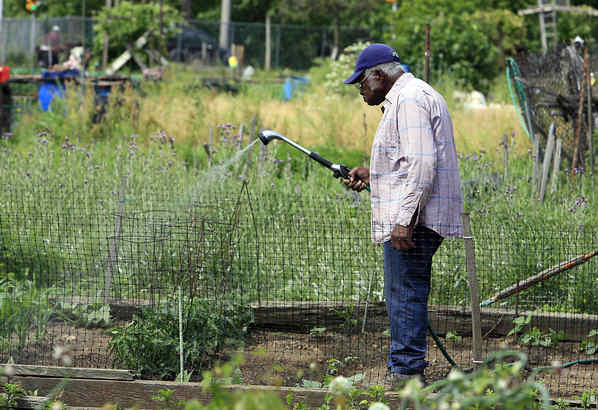
photo credit: Akira Suwa; Inquirer Staff
source:
http://www.philly.com/philly/living/...od__pride.html
Tue, Jun. 15, 2010
Keystone Gardens: Deep-rooted sources of food, pride
By Vernon Clark
Inquirer Staff Writer
In the morning sunshine, Darlene Marcus walks between the rows of garden plots at a massive green oasis in North Philadelphia, as she has during growing seasons for about 20 years. Marcus pointed to the vegetables starting to sprout at Glenwood Green Acres, the largest community garden, and one of the oldest, in Philadelphia; 90 rectangular plots on this 3.5-acre stretch.
In a city with about 400 community gardens, Glenwood Green Acres - which spans Glenwood Avenue from 18th to 19th Streets and is bounded by railroad tracks - is held in a special class by the Pennsylvania Horticultural Society, which provides a variety of services to community gardens. Glenwood Green Acres, on the site of a former whiskey factory, is one of nine Philadelphia gardens designated as Keystone Gardens.
Eileen Gallagher, a spokeswoman for the Horticultural Society, said the designation was for gardens distinguished by their large size, longevity, and commitment. The society gives them support and counseling so they can be self-sustaining over the long term. The nine Keystone Gardens are an average size of one-quarter to one-half acre, officials said. The gardeners keep their produce and share it with neighbors and neighborhood groups. They contribute a portion of their produce to the City Harvest program, which was established by the Horticultural Society. City Harvest has received more than 55,000 pounds of produce since its founding in 2006, Gallagher said. The Neighborhood Gardens Association/A Philadelphia Land Trust, a nonprofit group, is dedicated to the long-term preservation of community gardens and open space in low- and moderate-income neighborhoods.
In South Philadelphia, Ed Mitinger, 49, a leader at Southwark Community Garden, another Keystone Garden, walks through the 60 plots of flowers and vegetables on about an acre at 311-33 Christian St. Mitinger, who also manages a natural-foods store, said Southwark had been in operation for 33 years. Besides focusing on plants, the Southwark garden aims to beautify the area, Mitinger said. One wall facing the garden consists of a large mural of mirrors arranged in an abstract design. "You get to enjoy some of the more expanded areas of the garden, whether you want to have a picnic here on a cool evening or read the Sunday paper," Mitinger said.



